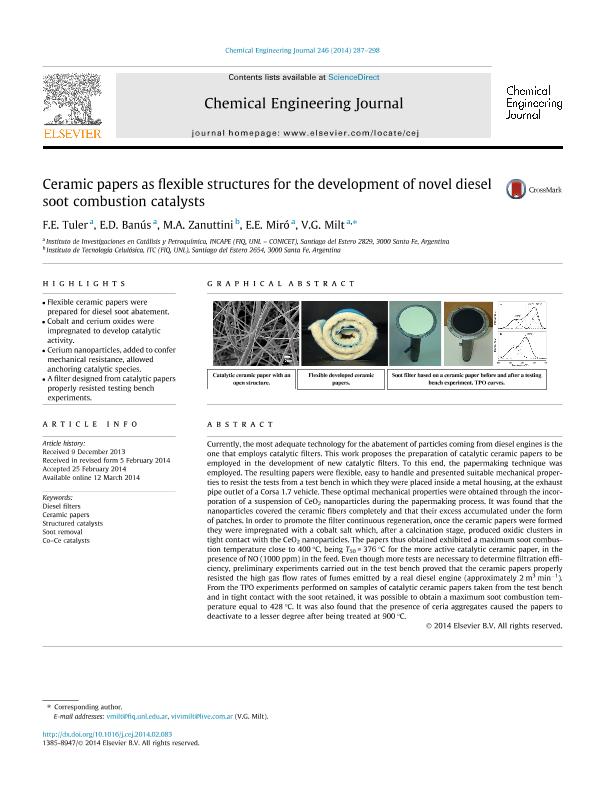Mostrar el registro sencillo del ítem
dc.contributor.author
Tuler, Fernando Esteban

dc.contributor.author
Banus, Ezequiel David

dc.contributor.author
Zanuttini, Miguel Angel Mario

dc.contributor.author
Miro, Eduardo Ernesto

dc.contributor.author
Milt, Viviana Guadalupe

dc.date.available
2017-12-21T15:01:27Z
dc.date.issued
2014-03
dc.identifier.citation
Milt, Viviana Guadalupe; Miro, Eduardo Ernesto; Zanuttini, Miguel Angel Mario; Banus, Ezequiel David; Tuler, Fernando Esteban; Ceramic papers as flexible structures for the development of novel diesel soot combustion catalysts; Elsevier; Chemical Engineering Journal; 246; 3-2014; 287-298
dc.identifier.issn
1385-8947
dc.identifier.uri
http://hdl.handle.net/11336/31206
dc.description.abstract
Currently, the most adequate technology for the abatement of particles coming from diesel engines is the one that employs catalytic filters. This work proposes the preparation of catalytic ceramic papers to be employed in the development of new catalytic filters. To this end, the papermaking technique was employed. The resulting papers were flexible, easy to handle and presented suitable mechanical properties to resist the tests from a test bench in which they were placed inside a metal housing, at the exhaust pipe outlet of a Corsa 1.7 vehicle. These optimal mechanical properties were obtained through the incorporation of a suspension of CeO2 nanoparticles during the papermaking process. It was found that the nanoparticles covered the ceramic fibers completely and that their excess accumulated under the form of patches. In order to promote the filter continuous regeneration, once the ceramic papers were formed they were impregnated with a cobalt salt which, after a calcination stage, produced oxidic clusters in tight contact with the CeO2 nanoparticles. The papers thus obtained exhibited a maximum soot combustion temperature close to 400°C, being T50 = 376°C for the more active catalytic ceramic paper, in the presence of NO (1000 ppm) in the feed. Even though more tests are necessary to determine filtration efficiency, preliminary experiments carried out in the test bench proved that the ceramic papers properly resisted the high gas flow rates of fumes emitted by a real diesel engine (approximately 2 m3.min-1). From the TPO experiments performed on samples of catalytic ceramic papers taken from the test bench and in tight contact with the soot retained, it was possible to obtain a maximum soot combustion temperature equal to 428°C. It was also found that the presence of ceria aggregates caused the papers to deactivate to a lesser degree after being treated at 900°C.
dc.format
application/pdf
dc.language.iso
eng
dc.publisher
Elsevier

dc.rights
info:eu-repo/semantics/openAccess
dc.rights.uri
https://creativecommons.org/licenses/by-nc-sa/2.5/ar/
dc.subject
Diesel Filters
dc.subject
Ceramic Papers
dc.subject
Structured Catalysts
dc.subject
Soot Removal
dc.subject
Co-Ce Catalysts
dc.subject.classification
Otras Ingeniería Química

dc.subject.classification
Ingeniería Química

dc.subject.classification
INGENIERÍAS Y TECNOLOGÍAS

dc.title
Ceramic papers as flexible structures for the development of novel diesel soot combustion catalysts
dc.type
info:eu-repo/semantics/article
dc.type
info:ar-repo/semantics/artículo
dc.type
info:eu-repo/semantics/publishedVersion
dc.date.updated
2017-12-21T14:10:44Z
dc.journal.volume
246
dc.journal.pagination
287-298
dc.journal.pais
Países Bajos

dc.journal.ciudad
Ámsterdam
dc.description.fil
Fil: Tuler, Fernando Esteban. Consejo Nacional de Investigaciones Científicas y Técnicas. Centro Científico Tecnológico Conicet - Santa Fe. Instituto de Investigaciones en Catálisis y Petroquímica ; Argentina
dc.description.fil
Fil: Banus, Ezequiel David. Consejo Nacional de Investigaciones Científicas y Técnicas. Centro Científico Tecnológico Conicet - Santa Fe. Instituto de Investigaciones en Catálisis y Petroquímica ; Argentina
dc.description.fil
Fil: Zanuttini, Miguel Angel Mario. Universidad Nacional del Litoral. Facultad de Ingeniería Química. Instituto de Tecnología Celulosica; Argentina. Consejo Nacional de Investigaciones Científicas y Técnicas. Centro Científico Tecnológico Conicet - Santa Fe; Argentina
dc.description.fil
Fil: Miro, Eduardo Ernesto. Consejo Nacional de Investigaciones Científicas y Técnicas. Centro Científico Tecnológico Conicet - Santa Fe. Instituto de Investigaciones en Catálisis y Petroquímica ; Argentina
dc.description.fil
Fil: Milt, Viviana Guadalupe. Consejo Nacional de Investigaciones Científicas y Técnicas. Centro Científico Tecnológico Conicet - Santa Fe. Instituto de Investigaciones en Catálisis y Petroquímica ; Argentina
dc.journal.title
Chemical Engineering Journal

dc.relation.alternativeid
info:eu-repo/semantics/altIdentifier/url/http://www.sciencedirect.com/science/article/pii/S1385894714002411
dc.relation.alternativeid
info:eu-repo/semantics/altIdentifier/doi/http://dx.doi.org/10.1016/j.cej.2014.02.083 1385-8947/ 2014 Elsevier B.V. All rights reserved
Archivos asociados
